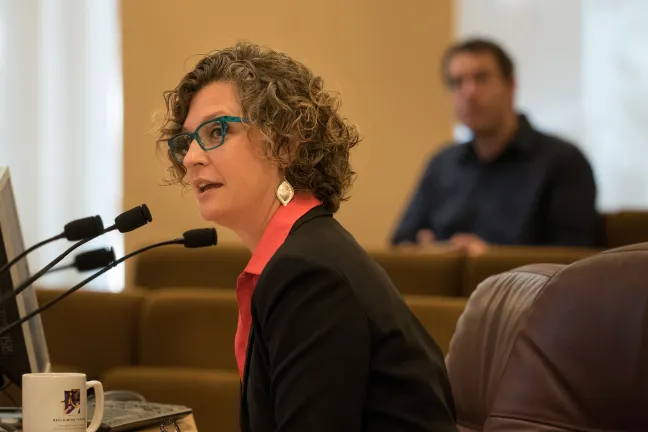The Multnomah County Board of Commissioners was updated Tuesday on efforts to reduce the county jail population through programs and policies aimed at providing alternatives to incarceration and reducing recidivism.
The briefing comes after the board’s approval of the county’s 2017 budget in May, which reduced funding for 118 jail beds from the county’s jails. Board members voted to reduce two 59-bed dorms from the jails and to hold more than $808,000 in contingency funding in case of an unanticipated need to keep beds available. The budget allows for the gradual closure of dorms and could also fund alternative programs to keep appropriate individuals out of jail and keep the community safe. A decision on jail use will likely happen this fall.
“I want to thank everyone for working so hard on this,” said Chair Deborah Kafoury at the beginning of Tuesday’s briefing. “I believe that we have the unique opportunity before us to invest our public safety dollars differently.”
“Jail is one of the most expensive options in our criminal justice system, yet it often does not get us the outcomes we want. As the Vera Institute noted, those booked- into jails are disproportionately people of color and far more likely than the general population to suffer from mental illness and substance abuse disorders. And we are working as a system, as we do so well, on several promising diversion programs and policy changes. I look forward to continuing this conversation about how we keep our public safe while we effectively reduce recidivism.”
Executive Director of the Local Public Safety Coordinating Abbey Stamp, Multnomah County Sheriff Mike Reese, Department of Community Justice Director Scott Taylor, District Attorney Rod Underhill and Chief Criminal Judge Edward Jones took part in a 75-minute presentation on the status of the changes.
Sheriff Reese detailed crime trends, average lengths of stay in jail and fluctuations in the average daily jail population over the past five years. At current levels, with one dorm that's not being used, Reese said the jail has flexibility to reopen a dorm if needed, but variables like booking numbers, can drive the population up.
“There were times when we have gone above that 95 percent and above the 1,251 (capacity with one dorm closed) in the last year,” Reese said while referencing a presentation. “If we were to close a second dorm at this point, we would be in an emergency population release mode.”
Board members were encouraged by the overall management of the jail population and new programs, slated to launch in early 2017, that will provide alternatives to jail for many low-level offenders. The Law Enforcement Assisted Diversion or LEAD program will allow law enforcement to divert low-level drug offenders from the jail to case management plans and services. New mental health screenings at jail booking will help divert those struggling with mental illness from the jail to treatment.
“I feel that our attention and focus is going to be that much greater on this population, and I also feel that we are beginning to address the real change,” said Commissioner Judy Shiprack.
Scott Taylor, director of the Department of Community Justice (DCJ), updated board members on a new sanction policy for parole and probation officers which has helped DCJ reduce its jail use by roughly 40 percent. Taylor stressed the new policy, which took effect in August, requires that parole and probation officers limit jail sanctions for offenders to three days for technical violations like failure to report to treatment or failure to abide by a parole officer’s directives -- not new crimes. Longer sanctions are permitted with supervisor’s approval, but a longer length of stay in jail is often less effective in changing offender behavior in the long term.
“You can only take so much vitamin C, and it helps you. But after a certain point, you are just wasting the vitamin C. So that’s kind of what we have to figure out, the dosage that we use on both treatment and incarceration (of offenders) and when we need to protect the community versus trying to change (criminal) behavior in the long term,” said Taylor.
Multnomah County District Attorney Rod Underhill lauded the county’s work to reduce lengths of stay in jail and the successes of its Justice Reinvestment program aimed at curtailing prison population. Underhill was optimistic about the partnership between law enforcement and the district attorney’s office in the LEAD program, which is based on a comparable Seattle program.
“We are interested in a number of things,” said Underhill. “Reducing the use of jail and reducing who goes to jail. The demographic will be a reduction in individuals of color.”
Other changes, aimed at reducing reliance on jails, include a shift for certain bench probation cases from judge-oversight to parole and probation's oversight and possible changes to automatic holds generated for certain offenders in the pretrial process-- that reversal would include safety mechanism and programs for victims.
Chief Criminal Judge Edward Jones added that a docket has also been established to better process mentally-ill offenders who cannot aid and assist in their defense.
“Are there people in the jail that we could successfully deal with at less cost in some other way? I think the answer is absolutely,” said Judge Jones. “We don’t need to keep our mentally-ill in a jail at a cost of $200 a day a jail.”
“We are trying to balance the goals of keeping people safe, which is our number one priority, but we are also looking at whether putting people in jail is really solving the problem that brought them there,” said Kafoury.



